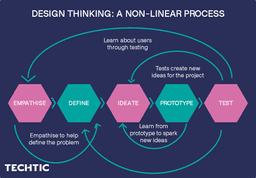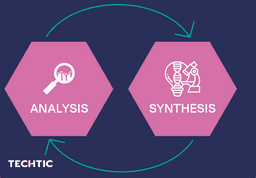What is Problem Statement in Design Thinking? With Example
Sector: UI/UX
Author: Nisarg Mehta
Date Published: 10/26/2020

Contents
All highly proposed solutions have one thing in common – airtight definitions of problems involved. Only when problems are identified, analyzed, and defined properly can solutions that are airtight and impactful solutions can be developed.
As business owners, it is on us to develop super-resourceful potential solutions to concerns our users are facing on a daily basis. And to develop effective solutions, a lot of disruptors and strategists make use of a super-niche and a systematic process called design thinking.
What is Design Thinking?

In simple words, it is a methodology that allows you to develop solutions to some of the most complex concerns people could ever encounter. Through a series of steps that involve understanding human needs, redefining and reassessing the problems inhumane ways, ideating, adopting, prototyping, and testing, seamless solutions to a lot of day-to-day problems are tackled and solved.
Self-timers on your phone camera are one of the simplest examples of design thinking that addresses the concern of people having to extend their arms to take a good photo of themselves without shaking the frame.
What is a Problem Statement?
Problem statements are definitions of the actual problems faced by consumers or people and reframing them in human-centric ways. The process of the defined problem statement is part of the second stage of the design thinking process. This stage is preceded by a phase called empathize, which involves the identification and observation of problems your users are facing.
How Empathize Phase Helps You Define the Problem Better?
For those of you who are new to this, understand that the steps in the design thinking methodology are all interconnected. One cannot happen without the other. That’s why the first stage – empathize – is crucial for you to come up with impactive solutions.
In this stage, we as problem solvers understand and empathize with the problems our consumers face. We take efforts to connect with the problems and gain a holistic and deeper understanding of some of the issues involved. The sense of empathy is vital in design thinking as it allows you to come with the most simplified solutions to problems. It eliminates any instance of assumption and helps you approach problems objectively.
Generally, design thinkers empathize through exposure to
- Diverse opinions
- Perspectives
- Alternative approaches to thinking
- A myriad of questions on issues being faced, any specific patterns in concerns, introducing variants to already existing solutions, and more
- Varied options and more
The Problem Definition Stage
Once this is done, the defining stage begins with the kickstart of two inevitable processes – analysis and synthesis. Let’s quickly look at how they would help you deliver optimized solutions.

Analysis
As the name suggests, this is where you analyze problems and break them down into fragments for better comprehension. We identify the minutest of details that would make a greater impact in addressing solutions to concerns. It helps us relate to our consumers’ problems better.
Synthesis
With the results of our analyses, we move on to the next element called synthesis. In this stage, we put together the fragments we have collected and dissect the data in hand to come up with insights and patterns for better solution development.
The process of write a problem statement cannot happen without these two processes. They strengthen our approach to defining problem statements and look at multiple ways to solving the problem.
How to Define a Problem Statement?
Now that you know the impact of the empathize stage, let’s dive into the most critical part of the post – defining the problem statement.
To help you get a start, we are presenting to you three ways to define a problem statement. Let’s look at each individually.
Space Saturation and Group
This is the first stage in defining a problem statement that follows the empathize stage. This is where you organize all your findings from the previous stage and group them together. Grouping them could be based on any of the other methodologies you prefer such as mind mapping, clustering, and more.
Space saturation literally means filling up space – like a whiteboard or a wall – with insights, data, and other gatherings. This brings your project team together and ensures you all are on the same page, paving the way for meaningful thinking processes.
The 4 Ws
It’s a general notion that when you ask the right questions, you will receive the answers and directions that will take you down the right path. This aspect in design thinking incorporates such thoughts. That’s why design thinkers ask four important questions.
Who
The first question is who is experiencing the problem. An idea on this is the persona of your target audience that also includes demographics. Answers to who will allow you to implement features that will address the specific concerns faced by people in this category. For instance, healthcare apps designed for the elderly will have enlarged fonts and icons to accommodate their needs.
What
This involves addressing what the problem actually is. From the insights gathered during the empathize phase, you could pinpoint the problem and deliver solutions to accomplish them.
Where
This defines the space in which the problem is experienced by people. Is it online, offline, in a specific geographical location, or others? This helps you to have more context to the problem under discussion.
Why
This is perhaps the most important question of all as it helps you understand the purpose of your solution. Why should you address the problem? Is the problem worth solving? What value addition does it offer to users?
The 5 Whys
After the 4 Ws, the 5 Whys will allow you to dive deeper into addressing the problems and their solutions. One reason we don’t seem to find the most ideal solutions to our concerns is that we don’t seem to find out why we experience things we are facing in the first place.
For instance, a working professional intending to bring in a better fitness regime into their lifestyle often fails to keep up with their goals and visions. So, the problem here is them being unable to join your gym or a fitness program. To find out ideal solutions, let’s ask some questions, shall we?
- Why do they fail to follow a fitness program? Do they have an improper work-life balance?
- Why does their enthusiasm decrease after the initial few months? Is your program not that immersive? Do they need consistent motivation or incremental levels of challenges?
- Why are their fitness goals harder to meet? Are there no tracking systems in place to check caloric intake and burning?
- Why don’t they inculcate motivation from within? Are you not engaging with them enough? Do you have too many members and a few trainers?
- Why do they drop out? Is your pricing too high? Do they need flexible timings?
The questions here are just to help you get started. The more questions you could come up with, the more probabilities you are likely to explore.
Wrapping Up
So, these were the fundamental things you need to know about defining an effective problem statement. We are confident that you also understand the role of empathizing with your consumers and their problems to give rise to better problem identifications and resolutions.
The process of software development will be seamless if this methodology is followed to the dot. However, this might be too much for you to pull off by yourself. If you’re an entrepreneur single-handedly driving a web development company or a full stack development company, you need additional support in making the most of design thinking.
That’s why we recommend getting in touch with a reliable product development company like us to help you out with this stage. Our services ensure your products identifies the gap and solve real-world problems and bring about dynamic positive changes in your consumers’ life.
Latest Tech Insights!
Join our newsletter for the latest updates, tips, and trends.







